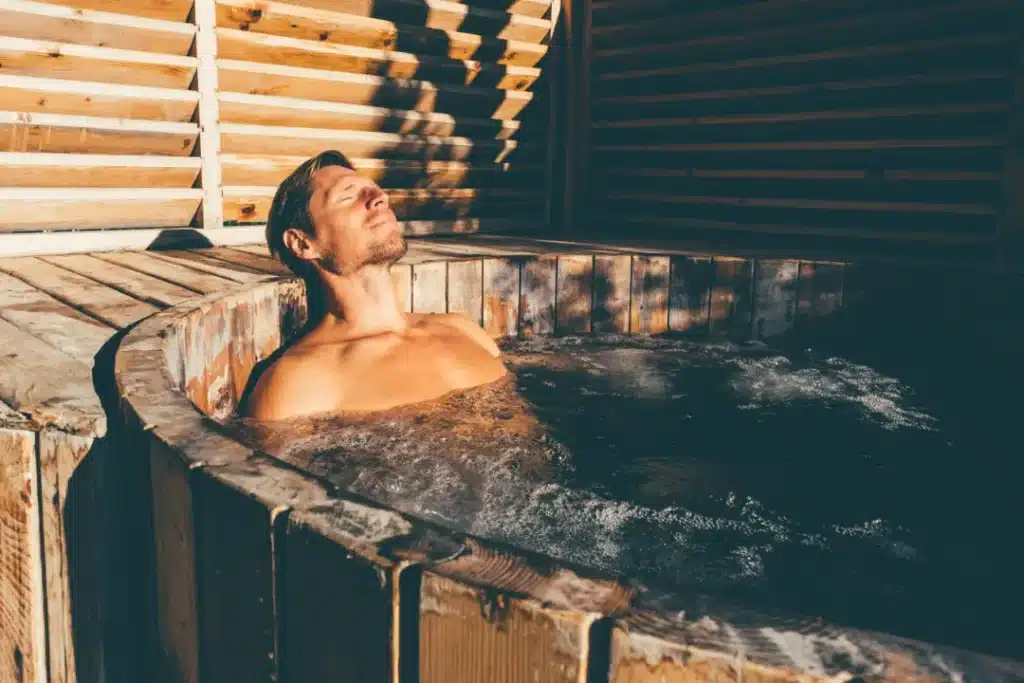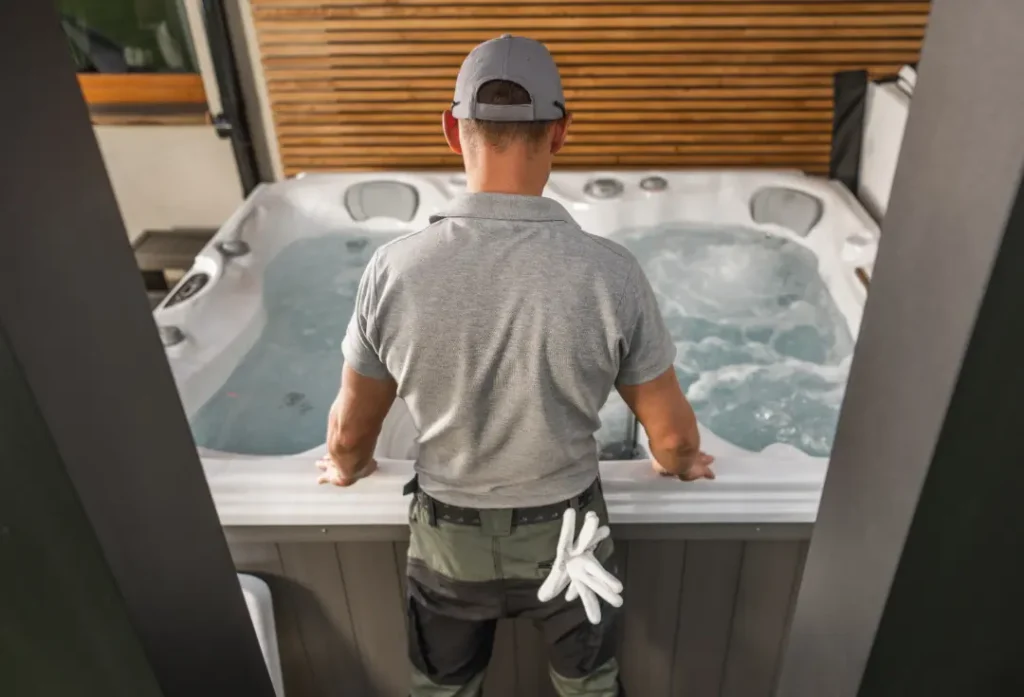For a safe and enjoyable hot tub experience, you need to know the basics of hot tub safety.
This includes safe entry and exit, maintaining water quality, and keeping children safe. Our guide provides essential tips to ensure your well-being.
Key Takeaways
- Ensure safe entry and exit from hot tubs using non-slip surface handrails and by moving cautiously.
- Maintain proper water quality and temperature to prevent health risks, keeping water pH balanced and temperatures below 104°F.
- Prioritize child safety by supervising them around hot tubs, using secure covers, and setting clear rules to prevent accidents.
Entry and Exit Tips
Safety starts with the first step into the hot tub and continues until you exit. Non-slip spa steps, handrails, and non-skid mats around the deck can significantly reduce the risk of slips and falls, especially for those with balance issues.
Move slowly and carefully when getting in and out of the hot tub, and avoid running or jumping straight in. Taking breaks between soaks helps prevent dizziness and provides a chance to cool down.
Health Considerations for Hot Tub Users
Health considerations are crucial for hot tub users. Those with heart disease should be cautious, as hot water can lower blood pressure and increase heart rate, straining the heart. Pregnant women should avoid water temperatures above 100 degrees Fahrenheit to minimize the risk of fetal damage.
Those on blood pressure medications need to be careful, as these can slow the heart rate, making it harder to cool down in warm water. Consult a healthcare provider if you have any health issues before using a hot tub.

Alcohol and Substance Use Risks
Drinking alcohol in a hot tub poses significant risks. It can impair judgment and coordination, increasing the likelihood of slips, falls, and drowning. The combination of hot water and alcohol can elevate heart rate and body temperature, leading to serious health issues like fainting or arrhythmias.
Avoid hot tubs when under the influence of alcohol or drugs to prevent dehydration and heat exhaustion, ensuring a safer and more enjoyable soak.
Hot Tub Water Quality
Maintaining hot tub water quality is essential for safety and comfort. Regular water testing helps prevent skin irritations and bacterial growth. To stabilize pH levels, keep pH levels between 7.2 and 7.6 for effective sanitizer performance and user comfort, and maintain total alkalinity between 80-120 ppm.
To effectively control bacteria, chlorine levels should be between 1 and 3 ppm and bromine between 2 and 4 ppm. A hot tub cover helps keep the water clean by preventing debris and contaminants from entering.
Child Safety in Hot Tubs
Keeping children safe around hot tubs requires constant vigilance. Adult supervision is critical whenever children are near the hot tub. Alarms on doors and windows can alert caregivers if a child approaches the hot tub area unsupervised, and a lockable gate can restrict access.
Set and enforce safety rules for older children, such as no rough play and limiting soak time to five minutes at 104°F. Lowering the temperature to 98°F allows for longer, safer soaks.
Infants and children under four years old should avoid hot tubs due to their susceptibility to overheating.
Electrical Safety Precautions
Electrical safety around hot tubs is crucial. Electric appliances should never be placed near hot tubs to reduce the risk of electrocution. Consider using battery-operated or Bluetooth devices instead of plug-in electronics and extension cords.
A qualified electrician can assess your hot tub setup to ensure compliance with safety standards and reduce risks. Turning off electrical components during storms prevents electrical hazards.
Following these tips creates a safe environment around your hot tub. Remember to follow hot tub safety tips.
Avoiding Overheating
Overheating is a serious risk when using hot tubs. Regularly checking the water temperature helps prevent related health issues. High water temperatures combined with alcohol can compromise the body’s ability to regulate temperature, increasing the risk of overheating.
Adhere to the manufacturer’s guidelines, typically limiting soaks to 15-minute intervals followed by breaks for safe hot tub use.
Proper Ventilation for Indoor Hot Tubs
Proper ventilation is essential for indoor hot tubs to manage humidity and air quality. Installing a robust exhaust fan can quickly remove humidity and protect indoor structures from steam damage. Ventilation systems with timers and humidistats help optimize air circulation and moisture management.
Ceiling fans can further enhance air circulation, creating a more comfortable environment in the hot tub room. Proper ventilation prevents vapor buildup and related respiratory issues.

Safe Hot Tub Accessories
Using safe accessories around your hot tub is essential. Opt for plastic cups, bottles, or cans instead of glass to prevent injuries from broken shards. Non-breakable dishware helps avoid accidents that could require draining the spa.
Rubber mats around the hot tub can also enhance safety by preventing slips.
Preventing Drowning
Preventing drowning is a top priority for hot tub safety. When not in use, cover your hot tub with a secure lockable safety cover to help prevent accidental drownings and keep children away when unsupervised.
Educating all users about safety procedures and emergency exits is crucial for safe hot tub use.
Weather Awareness
Weather conditions can significantly impact hot tub safety, and using a hot tub during a thunderstorm poses a serious risk of electrocution from lightning strikes. If a thunderstorm approaches, exit immediately and seek shelter indoors. Wait at least 30 minutes after the last thunder or lightning before resuming hot tub use.
Encouraging Cleanliness
Cleanliness is key to maintaining hot tub hygiene. Showering before entering helps eliminate germs and personal products from the skin, enhances water hygiene, and reduces the need for disinfectants. Rinsing after using the hot tub to prevent chemical residues from remaining on the skin.
Monitoring Water Temperature
Regularly checking the water temperature helps prevent overheating and related health issues. Hot tub water temperatures should not exceed 104 degrees Fahrenheit to avoid health risks. Thermometers are recommended to ensure accuracy, as built-in thermostats may not always be reliable.
Maintaining Your Hot Tub Cover
A well-maintained hot tub cover protects water quality and prevents unauthorized access. Covers help conserve heat, reduce energy costs associated with heating the hot tub, and prevent water evaporation, minimizing the frequency of refills.
Many hot tub covers feature lockable latches for added safety. Regular maintenance enhances the cover’s protective and conserving capabilities.

Creating a Safe Environment
Creating a safe hot tub environment involves several measures. Choosing an installation site away from slippery areas can help prevent accidents. Anti-skid treads, rubber mats, and handrails enhance traction around the hot tub.
Keeping the area well-lit, especially at night, helps prevent falls and accidents.
Action Spa Repairs Prioritizing Fun and Safety
Keeping your hot tub safe and enjoyable is not just about regular cleaning; it also requires professional care. Action Spa Repairs is dedicated to ensuring your hot tub stays a safe place to relax. Our experts can identify and fix any issues that might put you at risk, like blocked suction fittings or faulty electrical components. By trusting us to maintain your hot tub, you can enjoy your soak, knowing that every safety measure is in place.
Summary
Safety should always be your top priority when using your hot tub. Make sure to enter and exit carefully using non-slip surfaces and handrails. Keep your water clean and balanced to avoid health problems, and always watch over children near the hot tub. Following these simple guidelines allows you to enjoy a safe and relaxing experience every time.
Frequently Asked Questions (FAQs)
What should I do if the hot tub water is too hot?
Check the thermostat settings to make sure they are below 104°F. If the water is still too hot, contact a professional like Action Spa Repairs to inspect your hot tub.
How often should I test my hot tub water?
Test your hot tub water at least once a week to check pH levels, alkalinity, and sanitizer levels to ensure the water remains safe and clean.
Is it safe for children to use the hot tub?
Yes, but always supervise them closely. Keep the water temperature lower (around 98°F) and limit their soak time to 5-10 minutes. Avoid letting infants or toddlers use the hot tub.
Can I use electronic devices near the hot tub?
Using plugged-in devices near the hot tub is unsafe because they can cause electrocution. Instead, use battery-operated or waterproof devices.
How do I know if my hot tub cover is still effective?
A good hot tub cover should fit securely without any cracks, tears, or water damage. If it’s damaged or does not seal properly, it might be time to replace it.
